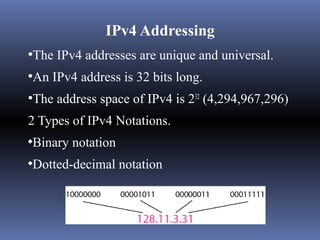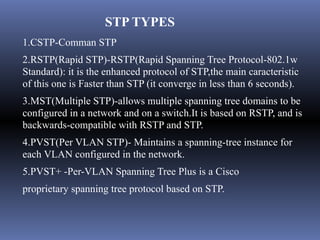Networking Fundamentals
- 2. IPv4 Addressing The IPv4 addresses are unique and universal. ● An IPv4 address is 32 bits long. ● The address space of IPv4 is 232 (4,294,967,296) ● 2 Types of IPv4 Notations. Binary notation  Dotted-decimal notation 
- 3. SUBNETTING AND VLSM Subnetting Divide a large address block into smaller subgroups. â—Ź Use of flexible net mask. â—Ź VLSM-Variable Length Subnet Mask Technique that allows network administrators to divide an IP address space into subnets of different sizes, unlike simple same-size Subnetting. â—Ź Subnetting a subnet. â—Ź
- 5. ROUTING PROTOCOLS Routing Protocol â—Ź Protocols used by routers to make path determination choices and to share those choices with other routers Autonomous system (AS) â—Ź Uses Interior Gateway Protocols as routing protocols A group of routers under the control of a single administration Interior Gateway Protocols (IGPs) â—Ź Routing protocols used within an AS Exterior Gateway Protocols (EGPs) â—Ź Routing protocols used to route information between multiple autonomous systems
- 6. ROUTING PROTOCOLS(continued) Examples of IGPs Routing Information Protocol (RIP) â—Ź Enhanced Interior Gateway Routing Protocol (EIGRP) â—Ź Open Shortest Path First (OSPF) â—Ź Example of EGP Border Gateway Protocol (BGP) â—Ź
- 7. ROUTING INFORMATION PROTOCOL(RIP) Routing Information Protocol (RIP) â—Ź The easiest Interior Gateway Protocol to configure is RIPv1 â—Ź A distance-vector routing protocol that broadcasts entire routing tables to neighbors every 30 seconds â—Ź RIP has a maximum hop count of 15 â—Ź As a result, RIP does not work in large internetworks â—Ź Enabling RIP Routing, the following commands are used, â—Ź Router(config)#router rip Router(config-router)#network 192.168.1.0 To troubleshoot RIP Routing, â—Ź Router#show ip rip
- 8. ENHANCED INTERIOR GATEWAY PROTOCOL(EIGRP) EIGRP is a Cisco-proprietary Hybrid routing protocol, incorporating features of both Distance-Vector and Link-State routing protocols. â—Ź It sends routing updates only when network topology changes instead of its entire routing table at regular intervals. â—Ź Its convergence is very fast â—Ź It supports classless inter-domain routing (CIDR) and variable-length subnet masks â—Ź (VLSM) EIGRP Major Drawback â—Ź It is Cisco proprietary - it does not inter-operate with other vendors' devices. This, of course, is the big one. If you are working in a mixed environment, EIGRP doesn't make as much sense
- 9. EIGRP(Continued) EIGRP uses Diffusing Update Algorithm (DUAL)to determine the best path among all “feasible” paths. DUAL also helps ensure a loop-free routing environment. ● EIGRP will form neighbor relationships with adjacent routers in the same Autonomous System (AS) ● EIGRP traffic is either sent as unicasts, or as multicasts on address 224.0.0.10, depending on the EIGRP packet type. ● Reliable Transport Protocol (RTP) is used to ensure delivery of most EIGRP packets. ● EIGRP packets are Hello,Update,Query,Reply and Ack ●
- 10. EIGRP(Continued) EIGRP, much like OSPF, builds three separate tables, Neighbor table– list of all neighboring routers. neighbors must belong to the same Autonomous System ● Topology table– list of all routes in the Autonomous System ● Routing table– contains the best route for each known network ● Enabling EIGRP Routing, the following commands are used, ● Router(config)#router eigrp 100 Router(config-router)#network 10.10.1.0 To troubleshoot EIGRP Routing,following commands are used, ● Router#show ip route eigrp Router#show ip eigrp neighbor Router#show ip eigrp traffic
- 11. OPEN SHORTEST PATH FIRST(OSPF) PROTOCOL OSPF is a standardized Link-State routing protocol,designed to scale efficiently to support larger networks â—Ź Special routers (autonomous system boundary routers) or backbone routers responsible to dissipate information about other AS into the current system. â—Ź It minimizes routing table entries by dividing AS into areas â—Ź Fast convergence Protocol â—Ź Low bandwidth requirements â—Ź Supports different types of areas â—Ź Route summarization and authentication â—Ź Cisco's implementation is fully compliant with the specification OSPF v2. â—Ź
- 12. OSPF(Continued) OSPF Packet Types, â—Ź Hello packets â—Ź Database Description (DBD) â—Ź Link-State Request (LSR) â—Ź Link-State Update (LSU) â—Ź Link-State Acknowledgement (LSA) Different Types of LSAs, Router LSA â—Ź Network LSA â—Ź Network Summary LSA â—Ź ASBR Summary LSA â—Ź AS-External LSA â—Ź
- 13. OSPF(Continued) Enabling OSPF Routing, the following commands are used, â—Ź Router(config)#router ospf 1(process id) Router(config-router)#network 192.168.1.1 0.255.255.255 area 1 To troubleshoot OSPF Routing,following commands are used, â—Ź Router# show ip route Router# show ip ospf Router# show ip ospf interface Router# show ip ospf neighbor Router# show ip ospf database
- 14. BORDERED GATEWAY PROTOCOL(BGP) Routing Protocol used to exchange routing information between Autonomous System â—Ź Exterior gateway protocol and path vector protocol â—Ź A Path vector protocol defines a route as a pairing between a destination and the attributes of the path to that destination â—Ź Types of BGP Messages are Open,update, Keep-alive and Notification â—Ź Two types of BGP External BGP Peering (eBGP) Internal BGP Peering (iBGP)
- 15. BGP(Continued) Internal BGP (iBGP) BGP peer within the same AS â—Ź Not required to be directly connected â—Ź iBGP speakers need to be fully meshed â—Ź They originate connected networks â—Ź They do not pass on prefixes learned from other iBGP speaker â—Ź External BGP Peering (eBGP) Between BGP speakers in different AS â—Ź Should be directly connected â—Ź Do not run an IGP between eBGP peers â—Ź
- 17. SWITCHING IN VLAN'S Switches also have enabled the creation of Virtual LANs (VLANs). ● VLANs provide greater opportunities to manage the flow of traffic on the LAN and reduce broadcast traffic between segments. ● VLANs are groups of computers in an intelligent switched network. ● Allow us to split switches into separate (virtual) switches ● Only members of a VLAN can see that VLAN’s traffic ● VLAN'S Types, Port-based VLANs ● MAC address based ● Protocol based VLANs ● Application based VLANs ●
- 18. VIRTUAL TRUNKING PROTOCOL(VTP) VTP reduces the complexity of managing and monitoring VLAN networks ● VTP maintains VLAN configuration consistency across a common network administration domain ● VTP allows VLANs to be trunked over mixed media ● VTP provides for accurate tracking and monitoring of VLANs ● VTP provides “Plug-and-Play” configuration when adding new VLANs ● VTP switches operate in one of three modes: Server – default mode. Sends VLAN information to other switches. ● Client – receives VLAN information and forwards it to other switches. ● Transparent – forward VTP traffic but do not originate or use it. They can have their own VLANs, not shared with other switches. ●
- 19. VTP(Continued) Command to set the VTP mode: Switch(vlan)#vtp {client | server | transparent} VTP Pruning-VTP pruning increases network available bandwidth by restricting flooded traffic to those trunk links that the traffic must use to reach the destination devices VLAN3 VLAN1 VLAN4 VLAN2
- 20. SPANNING TREE PROTOCOL(STP) STP is a link management protocol that provides path redundancy while preventing undesirable loops in the network ● Spanning Tree Algorithm The switches use this algorithm to decide which ports should be shut down. Choose one switch to be “root bridge” ● Choose a “root port” on each other switch ● Choose a “designated port” on each segment. ● Close down all other ports. ●
- 22. STP TYPES 1.CSTP-Comman STP 2.RSTP(Rapid STP)-RSTP(Rapid Spanning Tree Protocol-802.1w Standard): it is the enhanced protocol of STP,the main caracteristic of this one is Faster than STP (it converge in less than 6 seconds). 3.MST(Multiple STP)-allows multiple spanning tree domains to be configured in a network and on a switch.It is based on RSTP, and is backwards-compatible with RSTP and STP. 4.PVST(Per VLAN STP)- Maintains a spanning-tree instance for each VLAN configured in the network. 5.PVST+ -Per-VLAN Spanning Tree Plus is a Cisco proprietary spanning tree protocol based on STP.
- 23. VIRTUAL PRIVATE NETWORK(VPN) Creates a secure tunnel over a public network â—Ź Uses the Internet as the public backbone to access a â—Ź secure private network Remote employees can access their office network â—Ź VPN Protocols PPTP (Point-to-Point tunneling Protocol) â—Ź L2F (Layer 2 Forwarding Protocol) â—Ź L2TP (Layer 2 Tunneling Protocol) â—Ź IPSec (Internet Protocol Security) â—Ź
- 24. IPsec(IP security) Provides Layer 3 security (RFC 2401) â—Ź Transparent to applications (no need for integrated IPSec support) â—Ź A set of protocols and algorithms used to secure IP data at the network layer â—Ź Combines different components: Security associations (SA) â—Ź Authentication headers (AH) â—Ź Encapsulating security payload (ESP) â—Ź Internet Key Exchange (IKE) â—Ź
- 25. Ipsec Modes Tunnel Mode Entire IP packet is encrypted and becomes the data component of a new (and larger) IP packet. ● Frequently used in an IPsec site-to-site VPN ● Transport Mode Ipsec header is inserted into the IP packet ● No new packet is created ● Works well in networks where increasing a packet’s size could cause an issue ● Frequently used for remote-access VPNs ●
- 27. THANK YOU



























